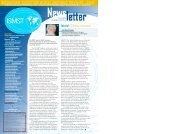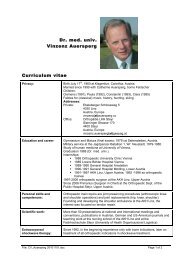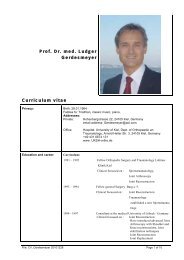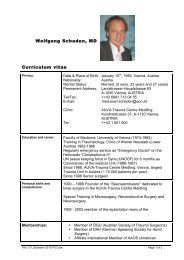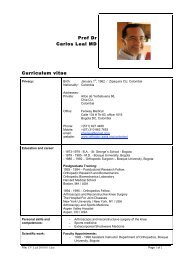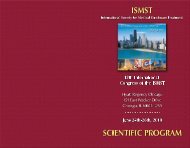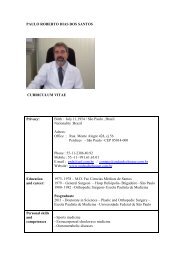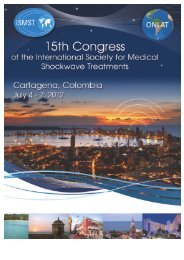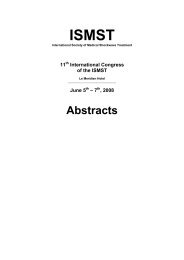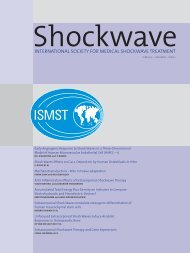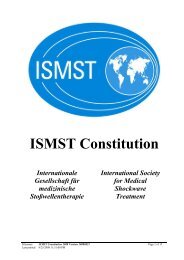Abstracts - ISMST - International Society for Medical Shockwave ...
Abstracts - ISMST - International Society for Medical Shockwave ...
Abstracts - ISMST - International Society for Medical Shockwave ...
You also want an ePaper? Increase the reach of your titles
YUMPU automatically turns print PDFs into web optimized ePapers that Google loves.
<strong>Abstracts</strong><br />
shock waves were used <strong>for</strong> the treatment of bone pseudoarthrosis in humans. Here we report our experience in Verona<br />
treating bone pseudoarthrosis by means of ESWT.<br />
Methods: Between 1997 and 2009 a total of 674 bone pseudarthrosis were treated, with a minimum follow up of 6 months<br />
Most consisted of long bone pseudarthrosis.<br />
The electromagnetic coil lithotripter (Modulith SLK by Storz <strong>Medical</strong> AG) used included in-line radiographic targeting<br />
and the Lithotrack system. The protocol usually consisted of one cycle of 3-4 sessions depending on the intrinsic<br />
characteristics of pseudarthrosis<br />
Typically no general or local anesthesia was required. All pseudarthrosis, if not surgically stabilized or well fixed, were<br />
immobilized with a brace.<br />
Results: Bony union was achieved in 78.6% of patients. Failures were experienced more often in atrophic pseudarthrosis.<br />
Some bones (humerus and carpal scaphoid) proved to be less sensitive to shock waves than others.<br />
No serious complications were observed.<br />
Discussion: The success rate of ESWT is very high and is comparable to results obtained with surgical procedures. It is a<br />
non-invasive method, and surgery can still be per<strong>for</strong>med if <strong>Shockwave</strong> Therapy fails. Moreover the mass of data analyzed<br />
furnishes in<strong>for</strong>mation concerning more exact indications and new prognostic factors.<br />
Conclusion: These considerations led to consider ESWT as a therapeutic method not only characterized by a high<br />
success rate, but also that is well tolerated and accepted by patients because of its non-invasiveness and absence of<br />
complications. Also considering its low cost compared to surgery, we can say that ESWT should be proposed as the first<br />
approach to bone pseudarthrosis.<br />
28. Quality Control of ESWT in the treatment of Non-Union fractures<br />
Wolfgang Schaden(1), Andreas Fischer(2), Ender Karadas(2), Rainer Mittermayr(1)<br />
Institution:<br />
1 AUVA Trauma Centre Meidling, Vienna, Austria + shockwavetherapy-vienna.com<br />
2 AUVA Trauma Centre Meidling, Vienna, Austria<br />
Device and producing company: Ossatron, HMT, Orthowave 280, TRT and MTS<br />
Introduction: Since December 1998 delayed and non-union fractures have been treated with ESWT on a regular basis in<br />
the AUVA Trauma Centre Meidling. Up to December 2009 a total of 1611 patients were treated and 70 parameters were<br />
documented <strong>for</strong> each patient. The data set includes demographic data, medical history, treatment parameters, side<br />
effects, and follow-up treatment as well as 3 and 6-month results. Since 153 (9.5%) patients were lost to follow-up, data<br />
<strong>for</strong> only 1458 patients is available.<br />
Methods: Because the data were collected in a linked access database some important correlations can be made<br />
immediately. The database will be demonstrated during the presentation and the audience will have the opportunity to ask<br />
questions concerning age of the patients, age of the non-unions, treatment parameters, etc. in correlation to the outcome<br />
(3 and 6-month results).<br />
For example,<br />
Question: “What was the healing rate in patients over 80 years of age that received ESWT <strong>for</strong> their non-unions?”<br />
Answer: n = 50 (14 male/34 female); mean age: 83.8 (range: 80-93); 47 fractures / 3 osteotomies; metaphyseal = 27 /<br />
diaphyseal = 23; healing rate after 3 months: 32 (64%); after 6 months: 42 (84%).<br />
Results: The overall healing rate was 77% (1120). Only minor side effect, such as temporary superficial haematoma,<br />
petechial bleedings and reddening of the skin, were observed. None of them had a clinical impact and disappeared after 3<br />
to 5 days without treatment.<br />
Discussion: The quality control facilitated by collecting these data enabled us to optimize treatment parameters. The<br />
treatments were per<strong>for</strong>med by a total of 25 trauma surgeons and there were no significant differences in the outcomes<br />
between the physicians.<br />
Conclusion: These results prove that ESWT <strong>for</strong> the treatment of delayed and non-healing fractures is not only efficient and<br />
safe but has practically no learning curve and is easily reproducible.<br />
25



